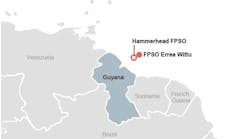1998 survey shows units operating, idle, under construction
Marshall DeLuca
Business Editor
Bluewater's Glas Dowr FPSO.
Survey explanation
- Survey - Operating [16,584 bytes]
- Survey - Operating cont., Idle, Under Construction [18,033 bytes]
- Survey - Under Construction cont., Planned/Projected [19,801 bytes]
The under construction section lists the field, operator, water depth, installation date, shipyard performing the construction, and whether the vessel is being converted or a newbuild. The third section, planned or projected projects, lists the location, operator, water depth, and installation date of each project.
A total of 79 floating production, storage, and offloading (FPSO) vessels are operating, idle, or under construction worldwide. Of the 79 vessels, 56 are operating in some area of the world. Three are idle. The UK sector of the North Sea holds the highest number of operating FPSO units (12), followed by China (8) and Australia (5).Various shipyards, such as Samsung, Mitsui, and FELS, currently have 20 FPSO units under construction. Eight of these vessels are newbuilds. The remainder are conversions. Most are destined for Brazil and Norway within the coming years.
At the present, there are 57 projects in some stage of development that are considering or planning to use FPSO's for development. Of these 57, Australia and Norway hold the most opportunities with nine developments each under consideration. These are followed closely by the UK (6), Angola (4), Brazil (4), and Vietnam (4).
Future growth
The FPSO fleet is expected to grow quickly in the coming years. This is due to the increased need for fast-track development, deepwater production, and the increasing number of large fields being discovered offshore with new technology.To keep up with demand, operators have begun building some of the largest FPSOs ever. This is evidinced with the recent roll-out of BP's Schiehallion, the world's largest existing FPSO, and the even larger Laminaria for Woodside, currently set for delivery next year. However, both vessels will be dwarfed by the massive FPSO currently planned for Elf's Girassol discovery. Construction for this vessel is planned to begin next year. There has also been talk of another FPSO for Elf's nearby Dalia Field.
There are also a number of highly prolific vessels currently under construction in the world's shipyards. Vessels destined for Norway's Åsgard and Pierce developments are due in the next year, as well as the FPSO for Canada's Terra Nova development. Petrobras is also continuing its stance as an industry leaded with four vessels currently undergoing conversion for their Campos Basin area. Other companies such as Texaco, and Shell also have projects currently on-line and many due to begin within the coming year.
Copyright 1998 Oil & Gas Journal. All Rights Reserved.




